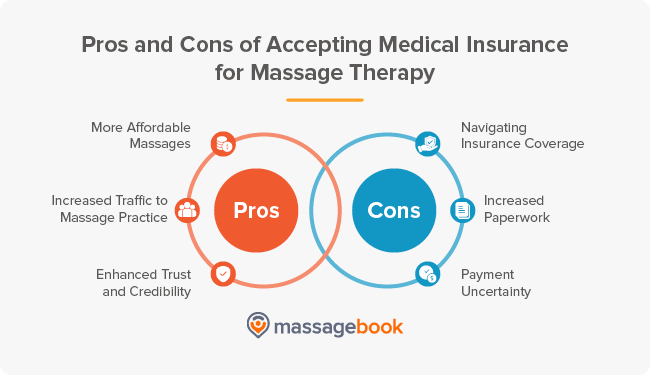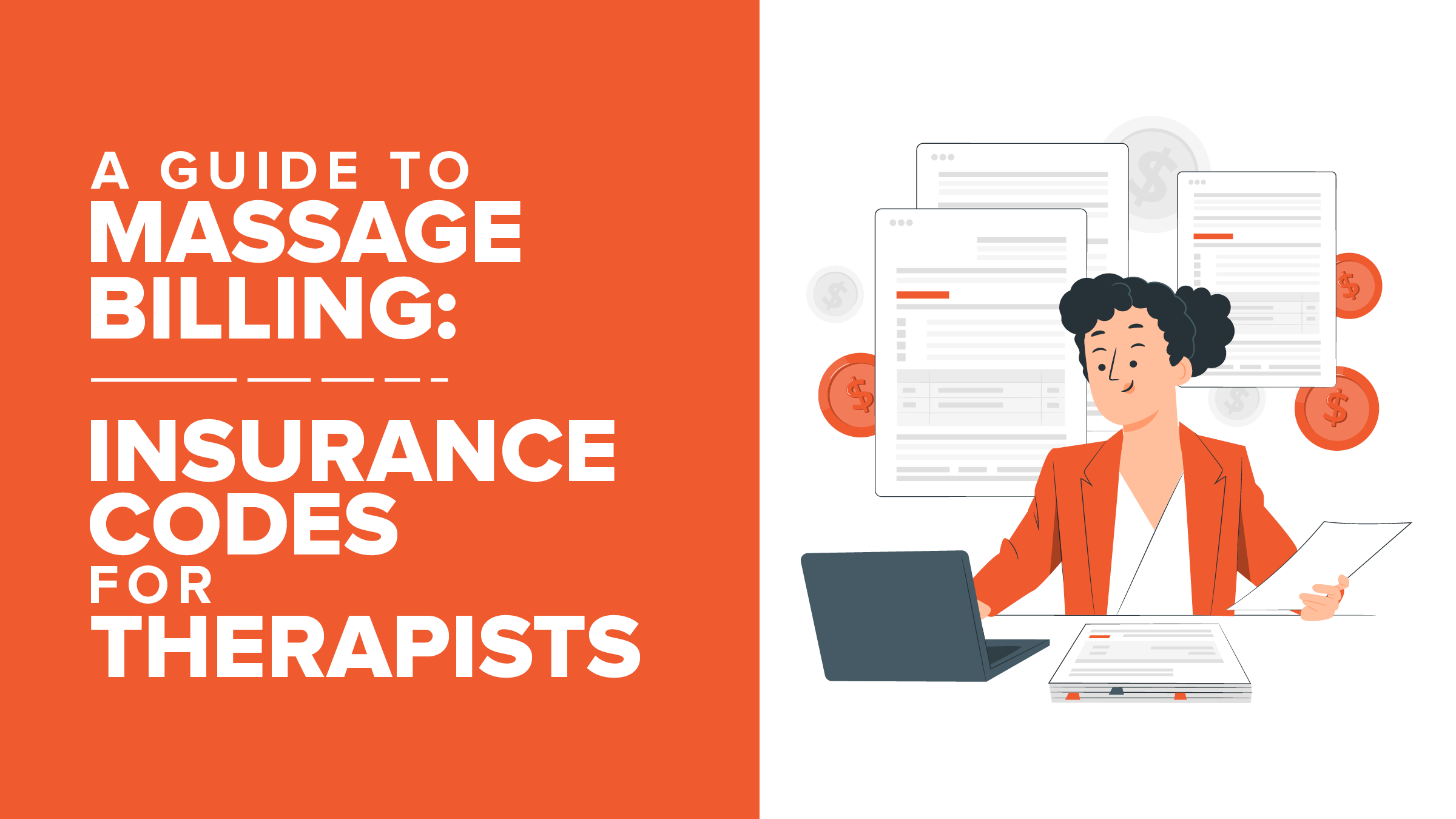Contents
In this guide, we’ll cover the following topics to help you learn more about accepting insurance and massage therapy billing codes:
- FAQs about massage billing
- Understanding massage therapy billing codes
- How to avoid massage billing delays and denials: 5 tips
- How software helps with massage billing
Venturing into the medical world can be overwhelming, as there are many rules and regulations that you need to comply with. Let’s look at the basics of massage billing and medical insurance and help you evaluate whether accepting insurance for massage billing is the right move for your practice.
FAQs about massage billing
Should I accept insurance coverage for massage billing?
There are many benefits to accepting insurance as a massage therapist, such as:
- Improved massage affordability. Some individuals who need medical massage care may not be able to afford it out of pocket. If your practice accepts their medical insurance, massages will be more accessible to those clients.
- Increased traffic to your massage practice. More affordable massages lead to more bookings. Plus, you’ll be more likely to retain clients, as not every massage provider will accept their insurance.
- Enhanced trust and credibility. By accepting health insurance, your practice will essentially offer healthcare services. This will enhance clients’ trust in your practice to deliver high-quality massage therapy. By highlighting this in your marketing, you’ll also differentiate your business from competitors.
While accepting medical insurance payments offers many advantages, it also has some downsides, such as:
- Navigating insurance coverage. Not all insurance providers cover massage therapy. Research the most common insurance providers in your area. If they don’t cover massages, it may not be worth it for you to accept insurance.
- Increased paperwork. Working with medical insurance requires filling out additional paperwork for insurance companies. You may also need to appeal denied claims, so you must be able to manage extra paperwork on top of existing responsibilities.
- Payment uncertainty. Insurance providers may deny your claims. In that case, you may not receive the entire payment. You’ll need to either bill your patient for the remaining balance or accept the partial payment.
Ultimately, it’s up to you to determine if the benefits outweigh the costs for your practice. Only you know whether you’d be able to successfully accept medical insurance.

What do you need to accept insurance for massage billing?
To accept medical insurance, you’ll need different qualifications and documents. These will vary depending on local or state laws, but in general, you will need the following:
- License to practice massage therapy
- National Provider Identifier (NPI)
- Prescription for massage therapy
- Current Procedural Terminology (CPT) codes
- Detailed SOAP (Subjective, Objective, Assessment, and Plan) treatment notes
Double-check how insurance billing works with your massage practice board and ask them any questions. Additionally, you’ll need a system for collecting and storing information about the massage sessions you provide, such as a SOAP notes tool, to support payment requests by proving that you provided a legitimate service to your clients.
What is patient reimbursement for massage therapy billing?
While working with insurance has its drawbacks, there’s a way for you to work with clients who need insurance without fronting the risks.
Instead of handling insurance yourself, ask patients to seek reimbursement from their insurance themselves. After you’ve seen a client with a prescription for massage therapy, provide them with a superbill detailing all the treatments they received. The client will pay you for your services and submit that superbill to their insurance provider. The insurance provider will then reimburse the client for the payment they made to you.
Although this strategy still requires additional paperwork, it removes the burden of submitting claims and dealing with insurance providers yourself. It also removes uncertainty around payments, as you’ll get paid either way!
Understanding massage therapy billing codes
The American Medical Association (AMA) created CPT codes to give structure to procedures and services performed by healthcare providers. These codes are also used for administrative purposes, such as insurance claims processing.
What are the common massage therapy billing codes?
The CPT codes most relevant for massage billing include:

- 97010: Hot and Cold Pack Therapy. This massage therapy billing code describes the application of any physical agent to produce therapeutic changes to biological tissue. Most commonly, it describes the application of moist heat, cryotherapy, or hydrotherapy. This billing code is not time-based and may only be billed once daily, so if your client has received this type of therapy from another medical practitioner, you will not be able to use this code. Here’s an example of how Horizon Blue deals with this code.
- 97124: Massage Therapy. This CPT code describes a therapeutic massage procedure in one or more areas. It includes effleurage, petrissage, and tapotement. This code is time-based and billed in increments of 15 minutes. Although this massage billing code is similar to 97140: Manual Therapy, it differs in intent. If you’re trying to increase circulation and tissue relaxation, bill 97124: Massage Therapy. Note that insurance providers tend to heavily scrutinize the use of massage and will only cover it when medically necessary.
- 97140: Manual Therapy. This massage therapy billing code describes manual therapy techniques, including mobilization, manipulation, manual lymphatic drainage, and manual traction, in one or more regions. This code is time-based and billed in increments of 15 minutes. 97140: Manual Therapy describes therapy that increases active pain-free range of motion, increases the extensibility of myofascial tissue, and facilitates the return to functional activities. You can only report codes 97124 and 97140 in the same session if you apply the different massage techniques to different areas of the patient’s body.
There are also some CPT codes that seem related to massage therapy, but their usage can get your claim rejected. Examples include codes 97110: Therapeutic Exercise and 97112: Neuromuscular Re-education. These codes are meant for physical therapists, so if you’re not trained or licensed as a physical therapist, your claim will likely be denied.
What are massage therapy billing code modifiers?
In addition to using the correct massage therapy billing codes, you may also need to clarify the intent and activity of your services with a CPT code modifier. Here are two common massage billing modifiers to know:

- -59: Distinct Procedural Service. This modifier identifies two similar procedures performed on the same individual on the same day or within a few days. For example, let’s say you’re reporting codes 97124: Massage Therapy or 97140: Manual Therapy alongside evaluation and management codes or chiropractic manipulation treatment codes. Append these codes with -59 to clarify that the massage services you’ve provided are separate from other services performed on the same day. However, using this modifier may raise flags with an insurance company and result in delayed payment.
- -52: Reduced Services. Use this massage therapy billing code modifier when a service or procedure is partially reduced or eliminated at the therapist’s discretion. This modifier may not be used on time-based codes, evaluations, or management services and should not be used to report the termination of a procedure. When using this modifier, explain why the procedure was discontinued and note the percentage of the procedure that was performed.
Double-check that you’re using these massage therapy billing code modifiers in the appropriate situations. Similarly to using incorrect codes, using incorrect modifiers can lead to denied claims.
What are massage therapy timed codes?
Timed versus untimed massage therapy billing codes add another layer of complexity to the billing process. We discussed earlier that certain billing codes are timed, such as 97124: Massage Therapy, which is billed in 15-minute increments. If your massage business accepts Medicare patients, you’ll need to learn the nuances between the two.
Let’s break it down a bit further:
- Untimed codes aren’t billed in specific time increments. This means that you’re reimbursed a predetermined fee, no matter how much time you spend on a treatment. You can only bill these codes once per treatment session.
- Timed codes are billed in 15-minute increments, and you’re reimbursed based on the time spent working with your client one-on-one. You can bill timed codes multiple times per session. If your treatment is not split into perfect 15-minute segments, apply the 8-minute rule—for the amount of time that isn’t divisible by 15, if it is over 8 minutes, then bill an additional unit.
As you fill out insurance forms with massage therapy billing codes, know if the code is timed or untimed to ensure you’re accurately reimbursed.
5 tips for avoiding massage billing delays and denials
While delays and denials are a definite drawback of accepting insurance at your practice, there are ways to mitigate this limitation. Here are five tips to avoid massage billing delays and denials:

- Get medical credentials for your practice. To accept insurance as a massage therapist, you’ll need to meet medical credentialing requirements. Many insurance companies require this, so it’s a good idea to collect and get the necessary documentation and licenses verified.
- Confirm insurance eligibility before appointments. A common issue with massage billing, or any type of medical billing, is that claims will be delayed or denied because of issues with a patient’s insurance coverage. Confirm your clients’ insurance eligibility before appointments to ensure that you receive payment for your services.
- Ensure that patients have massage therapy prescriptions. Since insurance providers usually only cover massage therapy if it’s medically necessary, check that patients have a medical prescription or referral for massage therapy from a physician. This will include a start date, number of visits, frequency of sessions, and diagnosis codes referencing the patient’s injury or condition. You can also use this information to form a treatment plan for your patient.
- Use accurate massage therapy billing codes. The AMA updates CPT codes and regulations annually. Stay up-to-date with them to ensure streamlined claims processing. Sometimes, codes are revised or discarded altogether, so double-check that you’re filing claims with the correct massage billing codes.
- Avoid scheduling massages alongside other provider visits. Due to limitations on certain massage therapy billing codes, avoid scheduling massage therapy sessions on the same day that a client has another provider visit. For example, code 97010: Hot and Cold Pack Therapy can only be billed once per day. That means if your client has received this therapy from another provider on the same day they visit your practice, you may not be able to receive full reimbursement for your massage services.
Although massage billing is complex, you can facilitate prompt insurance processing by incorporating these strategies. You’ll be able to minimize claim denials, ensuring that you receive the appropriate payment for your massage therapy services.
How software helps with massage billing
Accepting insurance as a massage therapist adds extra work to your plate, and you may feel that this extra effort is not worth the benefits. However, before you completely dismiss the idea, consider that the right massage therapy software solution can substantially improve your massage billing processes.
Some helpful massage therapy software features include:

- Scheduling. Since accepting insurance coverage makes massages more accessible and affordable, you may attract more clients. Massage therapy solutions often have online scheduling capabilities to simplify your workflow.
- Intake forms. Ask clients to fill out intake forms online before their appointment with massage therapy software. Use these intake forms to determine if clients are using insurance, verify if they have a prescription or referral, and check if they have another provider visit scheduled on the same day.
- Client database. Track client-specific information in a single, centralized location. This includes appointment history, contact information, and messages. You can also note if your client uses insurance, so you’ll know how to handle massage billing for them.
- SOAP notes. Insurance providers usually require detailed treatment notes for claims. Massage therapy solutions allow you to take secure, in-depth SOAP notes that record massage therapy billing codes. Plus, you’ll be able to create more detailed treatment plans for clients, helping you provide massages that relieve pain and address their medical needs.
- Payment processing. With massage therapy software, you can accept various payment methods, including HSA and FSA, and even split payments between different methods. Some solutions also enable you to offer insurance billing receipts, which list specific info for clients who want to submit receipts to their insurance provider. These receipts include the service date and time and the provider’s name, state license number, and unique NPI number.
Aside from these specific billing-related benefits, massage therapy software is beneficial for your practice in other ways. These solutions can improve client communication, keep your data organized, and even help you acquire and retain clients. Even if you decide not to accept insurance coverage, consider how massage therapy solutions can streamline your practice’s processes and address your pain points.
Additional resources
Although insurance providers have historically overlooked massage therapy, that attitude is changing, and accepting insurance as a massage therapist is becoming more viable. However, many rules and regulations can make it difficult to add insurance to your massage billing processes. Ultimately, it’s up to you to decide whether it’s worth it for your practice to make the change.
To learn more about running a massage therapy business, explore the following resources:
- 10+ Best Massage Therapy Software Solutions — Massage therapy solutions help practices in numerous ways, including making insurance billing more convenient. Read our list of the top massage therapy software solutions.
- SOAP Notes for Massage Therapists: Guide + Free Template — Even if you’re not planning on accepting insurance, having detailed SOAP notes can help you retain clients by providing exceptional massages. Check out our guide and download our free SOAP notes template!
- Massage Therapy Marketing: 15 Effective Ideas to Explore — Promoting your business is just as important as billing and proper service. Explore effective massage marketing techniques here.









